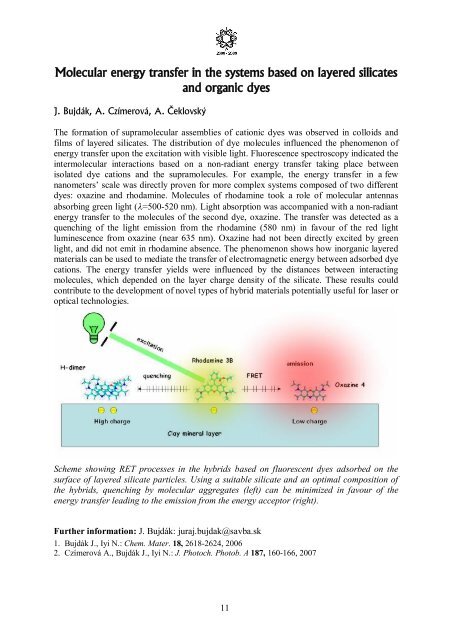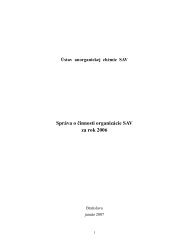Foreign Cooperating Institutions - Institute of Inorganic Chemistry ...
Foreign Cooperating Institutions - Institute of Inorganic Chemistry ...
Foreign Cooperating Institutions - Institute of Inorganic Chemistry ...
Create successful ePaper yourself
Turn your PDF publications into a flip-book with our unique Google optimized e-Paper software.
Molecular energy transfer in the systems based on layered silicates<br />
and organic dyes<br />
J. Bujdák, A. Czímerová, A. Čeklovský<br />
The formation <strong>of</strong> supramolecular assemblies <strong>of</strong> cationic dyes was observed in colloids and<br />
films <strong>of</strong> layered silicates. The distribution <strong>of</strong> dye molecules influenced the phenomenon <strong>of</strong><br />
energy transfer upon the excitation with visible light. Fluorescence spectroscopy indicated the<br />
intermolecular interactions based on a non-radiant energy transfer taking place between<br />
isolated dye cations and the supramolecules. For example, the energy transfer in a few<br />
nanometers’ scale was directly proven for more complex systems composed <strong>of</strong> two different<br />
dyes: oxazine and rhodamine. Molecules <strong>of</strong> rhodamine took a role <strong>of</strong> molecular antennas<br />
absorbing green light (λ=500-520 nm). Light absorption was accompanied with a non-radiant<br />
energy transfer to the molecules <strong>of</strong> the second dye, oxazine. The transfer was detected as a<br />
quenching <strong>of</strong> the light emission from the rhodamine (580 nm) in favour <strong>of</strong> the red light<br />
luminescence from oxazine (near 635 nm). Oxazine had not been directly excited by green<br />
light, and did not emit in rhodamine absence. The phenomenon shows how inorganic layered<br />
materials can be used to mediate the transfer <strong>of</strong> electromagnetic energy between adsorbed dye<br />
cations. The energy transfer yields were influenced by the distances between interacting<br />
molecules, which depended on the layer charge density <strong>of</strong> the silicate. These results could<br />
contribute to the development <strong>of</strong> novel types <strong>of</strong> hybrid materials potentially useful for laser or<br />
optical technologies.<br />
Scheme showing RET processes in the hybrids based on fluorescent dyes adsorbed on the<br />
surface <strong>of</strong> layered silicate particles. Using a suitable silicate and an optimal composition <strong>of</strong><br />
the hybrids, quenching by molecular aggregates (left) can be minimized in favour <strong>of</strong> the<br />
energy transfer leading to the emission from the energy acceptor (right).<br />
Further information: J. Bujdák: juraj.bujdak@savba.sk<br />
1. Bujdák J., Iyi N.: Chem. Mater. 18, 2618-2624, 2006<br />
2. Czímerová A., Bujdák J., Iyi N.: J. Photoch. Photob. A 187, 160-166, 2007<br />
11



